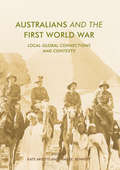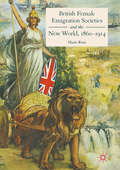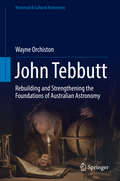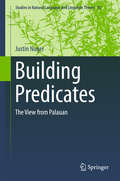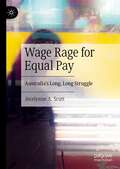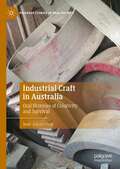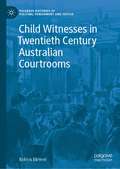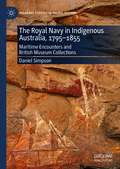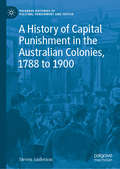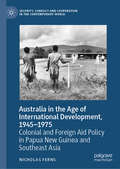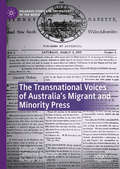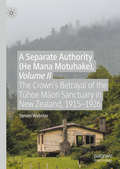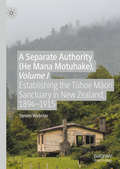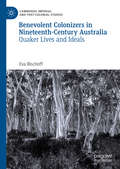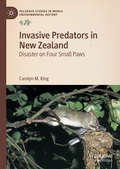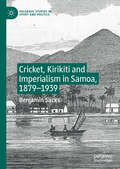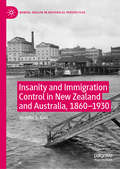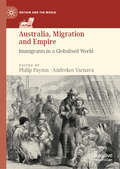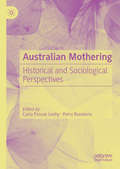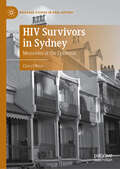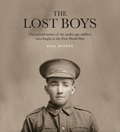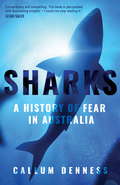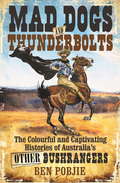- Table View
- List View
Australians and the First World War: Local-Global Connections and Contexts
by Kate Ariotti James E. BennettThis book contributes to the global turn in First World War studies by exploring Australians’ engagements with the conflict across varied boundaries and by situating Australian voices and perspectives within broader, more complex contexts. This diverse and multifaceted collection includes chapters on the composition and contribution of the Australian Imperial Force, the experiences of prisoners of war, nurses and Red Cross workers, the resonances of overseas events for Australians at home, and the cultural legacies of the war through remembrance and representation. The local-global framework provides a fresh lens through which to view Australian connections with the Great War, demonstrating that there is still much to be said about this cataclysmic event in modern history.
Australians and the First World War: Local-Global Connections and Contexts
by Kate Ariotti James E. BennettThis book contributes to the global turn in First World War studies by exploring Australians’ engagements with the conflict across varied boundaries and by situating Australian voices and perspectives within broader, more complex contexts. This diverse and multifaceted collection includes chapters on the composition and contribution of the Australian Imperial Force, the experiences of prisoners of war, nurses and Red Cross workers, the resonances of overseas events for Australians at home, and the cultural legacies of the war through remembrance and representation. The local-global framework provides a fresh lens through which to view Australian connections with the Great War, demonstrating that there is still much to be said about this cataclysmic event in modern history.
British Female Emigration Societies and the New World, 1860-1914
by Marie RuizThis book focuses on the departure of Britain’s 'surplus' women to Australia and New Zealand organised by Victorian British female emigration societies. Starting with an analysis of the surplus of women question, it then explores the philanthropic nature of the organisations (the Female Middle Class Emigration Society, the Women’s Emigration Society, the British Women’s Emigration Association, and the Church Emigration Society). The study of the strict selection of distressed gentlewomen emigrants is followed by an analysis of their marketing value, and an appraisal of women’s imperialism. Finally, this work shows that the female emigrants under study partook in the consolidation of the colonial middle-class.
British Female Emigration Societies and the New World, 1860-1914
by Marie RuizThis book focuses on the departure of Britain’s 'surplus' women to Australia and New Zealand organised by Victorian British female emigration societies. Starting with an analysis of the surplus of women question, it then explores the philanthropic nature of the organisations (the Female Middle Class Emigration Society, the Women’s Emigration Society, the British Women’s Emigration Association, and the Church Emigration Society). The study of the strict selection of distressed gentlewomen emigrants is followed by an analysis of their marketing value, and an appraisal of women’s imperialism. Finally, this work shows that the female emigrants under study partook in the consolidation of the colonial middle-class.
John Tebbutt: Rebuilding and Strengthening the Foundations of Australian Astronomy (Historical & Cultural Astronomy)
by Wayne OrchistonThis book marks the centennial of Tebbutt's death with a major biographical account surveying his scientific contributions to astronomy, prefaced with a foreword by Sir Patrick Moore. During the second half of the nineteenth century, Tebbutt was Australia's foremost astronomer. He devoted his time and funds to astronomy, and built a truly international reputation that far surpassed Australia's leading professional astronomers of the day. This book marks the centennial of Tebbutt's death with a major biographical account. Tebbutt's remarkable record of achievement extends over more than half a century.Orchiston's book covers the whole of Tebbutt's career, from his yearly observatory reports and comet discoveries to his time as the first president of Sydney's branch of the British Astronomical Association.
Building Predicates: The View from Palauan (Studies in Natural Language and Linguistic Theory #92)
by Justin NugerThis volume provides a comprehensive analysis of the syntax of Palauan that will appeal to anyone interested in Austronesian languages or formal syntactic and morphological theory. This volume proposes that words in Palauan are not drawn directly from a mental lexicon, but are instead composed at least partially in the syntax. Using original data from syntactic constructions not previously explored in the language, the author entertains several competing theories of word formation and highlights the compatible and incompatible aspects of each, through an exploration into new corners of Palauan syntax and morphology.
Wage Rage for Equal Pay: Australia’s Long, Long Struggle
by Jocelynne A. ScuttThis book makes a major contribution to the continuing legal and historical struggle for equal pay in Australia, with international references, including Canada, the UK and US. It takes law, history and women’s and gender studies to analyse and recount campaigns, cases and debates. Industrial bodies federally and around Australia have grappled with this issue from the early-twentieth century onwards. This book traces the struggle through the decades, looking at women's organisations activism and demands, union ‘pro’ and ‘against’ activity, and the 'official' approach in tribunals, boards and courts.
Industrial Craft in Australia: Oral Histories of Creativity and Survival (Palgrave Studies in Oral History)
by Jesse Adams SteinThis book is the first of its kind to investigate the ongoing significance of industrial craft in deindustrialising places such as Australia. Providing an alternative to the nostalgic trope of the redundant factory ‘craftsman’, this book introduces the intriguing and little-known trade of engineering patternmaking, where objects are brought to life through the handmade ‘originals’ required for mass production.Drawing on oral histories collected by the author, this book highlights the experiences of industrial craftspeople in Australian manufacturing, as they navigate precarious employment, retraining, gendered career pathways, creative expression and technological change. The book argues that digital fabrication technologies may modify or transform industrial craft, but should not obliterate it. Industrial craft is about more than the rudimentary production of everyday objects: it is about human creativity, material knowledge and meaningful work, and it will be key to human survival in the troubled times ahead.
Child Witnesses in Twentieth Century Australian Courtrooms (Palgrave Histories of Policing, Punishment and Justice)
by Robyn BlewerThis book considers the law, policy and procedure for child witnesses in Australian criminal courts across the twentieth century. It uses the stories and experiences of over 200 children, in many cases using their own words from press reports, to highlight how the relevant law was – or was not - applied throughout this period. The law was sympathetic to the plight of child witnesses and exhibited a significant degree of pragmatism to receive the evidence of children but was equally fearful of innocent men being wrongly convicted. The book highlights the impact ‘safeguards’ like corroboration and closed court rules had on the outcome of many cases and the extent to which fear – of children, of lies (or the truth) and of reform – influenced the criminal justice process. Over a century of children giving evidence in court it is `clear that the more things changed, the more they stayed the same’.
The Royal Navy in Indigenous Australia, 1795–1855: Maritime Encounters and British Museum Collections (Palgrave Studies in Pacific History)
by Daniel SimpsonThis book offers the first in-depth enquiry into the origins of 135 Indigenous Australian objects acquired by the Royal Navy between 1795 and 1855 and held now by the British Museum. In response to increasing calls for the ‘decolonisation’ of museums and the restitution of ethnographic collections, the book seeks to return knowledge of the moments, methods, and motivations whereby Indigenous Australian objects were first collected and sent to Britain. By structuring its discussion in terms of three key ‘stages’ of a typical naval voyage to Australia—departure from British shores, arrival on the continent’s coasts, and eventual return to port—the book offers a nuanced and multifaceted understanding of the pathways followed by these 135 objects into the British Museum. The book offers important new understandings of Indigenous Australian peoples’ reactions to naval visitors, and contains a wealth of original research on the provenance and meaning of some of the world’s oldest extant Indigenous Australian object collections.
A History of Capital Punishment in the Australian Colonies, 1788 to 1900 (Palgrave Histories of Policing, Punishment and Justice)
by Steven AndersonThis book provides a comprehensive overview of capital punishment in the Australian colonies for the very first time. The author illuminates all aspects of the penalty, from shortcomings in execution technique, to the behaviour of the dying criminal, and the antics of the scaffold crowd. Mercy rates, execution numbers, and capital crimes are explored alongside the transition from public to private executions and the push to abolish the death penalty completely. Notions of culture and communication freely pollinate within a conceptual framework of penal change that explains the many transformations the death penalty underwent. A vast array of sources are assembled into one compelling argument that shows how the ‘lesson’ of the gallows was to be safeguarded, refined, and improved at all costs. This concise and engaging work will be a lasting resource for students, scholars, and general readers who want an in-depth understanding of a long feared punishment.Dr. Steven Anderson is a Visiting Research Fellow in the History Department at The University of Adelaide, Australia. His academic research explores the role of capital punishment in the Australian colonies by situating developments in these jurisdictions within global contexts and conceptual debates.
Australia in the Age of International Development, 1945–1975: Colonial and Foreign Aid Policy in Papua New Guinea and Southeast Asia (Security, Conflict and Cooperation in the Contemporary World)
by Nicholas FernsThis book examines Australian colonial and foreign aid policy towards Papua New Guinea and Southeast Asia in the age of international development (1945–1975). During this period, the academic and political understandings of development consolidated and informed Australian attempts to provide economic assistance to the poorer regions to its north. Development was central to the Australian colonial administration of PNG, as well as its Colombo Plan aid in Asia. In addition to examining Australia’s perception of international development, this book also demonstrates how these debates and policies informed Australia’s understanding of its own development. This manifested itself most clearly in Australia’s behavior at the 1964 United Nations Conference on Trade and Development (UNCTAD). The book concludes with a discussion of development and Australian foreign aid in the decade leading up to Papua New Guinea’s independence, achieved in 1975.
The Transnational Voices of Australia’s Migrant and Minority Press (Palgrave Studies in the History of the Media)
by Catherine Dewhirst Richard ScullyThis edited collection invites the reader to enter the diverse worlds of Australia’s migrant and minority communities through the latest research on the contemporary printed press, spanning the mid-nineteenth century to our current day. With a focus on the rare, radical and foreign-language print culture of multiple and frequently concurrent minority groups’ newspaper ventures, this volume has two overarching aims: firstly to demonstrate how the local experiences and narratives of such communities are always forged and negotiated within a context of globalising forces – the global within the local; and secondly to enrich an understanding of the complexity of Australian ‘voices’ through this medium not only as a means for appreciating how the cultural heritage of such communities were sustained, but also for exploring their contributions to the wider society.
A Separate Authority (He Mana Motuhake), Volume II: The Crown’s Betrayal of the Tūhoe Māori Sanctuary in New Zealand, 1915–1926
by Steven WebsterFollowing on from Volume I on the formation of the Urewera District Native Reserve, this monograph examines the period from 1908 to 1926, during which time the Crown subverted Tūhoe control of the UDNR, established a mere decade earlier. While Volume I described how the Tūhoe were able to deploy kin-based power to manipulate Crown power as well as confront one another, this volume describes ways in which the same ancestral descent groups closed ranks to survive nearly two decades of predatory Crown policies determined to dismantle their sanctuary. A relentless Crown campaign to purchase individual Tūhoe land shares ultimately resulted in a misleading Crown scheme to consolidate and relocate Tūhoe land shares, thereby freeing up land for the settlement of non- Tūhoe farmers. By the 1950s, over 200 small Tūhoe blocks were scattered throughout one of the largest National Parks in New Zealand. Although greatly weakened by these policies in terms of kinship solidarity as well as land and other resources, Tūhoe resistance continued until the return of the entire park in 2014—with unreserved apologies and promises of future support. In both volumes of A Separate Authority (He Mana Motuhake), Webster takes the stance of an ethnohistorian: he not only examines the various ways control over the Urewera District Native Reserve (UDNR) was negotiated, subverted or betrayed, and renegotiated during this time period, but also focuses on the role of Māori hapū, ancestral descent groups and their leaders, including the political economic influence of extensive marriage alliances between them. The ethnohistorical approach developed here may be useful to other studies of governance, indigenous resistance, and reform, whether in New Zealand or elsewhere.
A Separate Authority (He Mana Motuhake), Volume I: Establishing the Tūhoe Māori Sanctuary in New Zealand, 1894–1915
by Steven WebsterThis book is an ethnohistorical reconstruction of the establishment in New Zealand of a rare case of Maori home-rule over their traditional domain, backed by a special statute and investigated by a Crown commission the majority of whom were Tūhoe leaders. However, by 1913 Tūhoe home-rule over this vast domain was being subverted by the Crown, which by 1926 had obtained three-quarters of their reserve. By the 1950s this vast area had become the rugged Urewera National Park, isolating over 200 small blocks retained by stubborn Tūhoe "non-sellers". After a century of resistance, in 2014 the Tūhoe finally regained statutory control over their ancestral domain and a detailed apology from the Crown.
Benevolent Colonizers in Nineteenth-Century Australia: Quaker Lives and Ideals (Cambridge Imperial and Post-Colonial Studies Series)
by Eva BischoffThis book reconstructs the history of a group of British Quaker families and their involvement in the process of settler colonialism in early nineteenth-century Australia. Their everyday actions contributed to the multiplicity of practices that displaced and annihilated Aboriginal communities. Simultaneously, early nineteenth-century Friends were members of a translocal, transatlantic community characterized by pacifism and an involvement in transnational humanitarian efforts, such as the abolitionist and the prison reform movements as well as the Aborigines Protection Society. Considering these ideals, how did Quakers negotiate the violence of the frontier? To answer this question, the book looks at Tasmanian and South Australian Quakers’ lives and experiences, their journeys and their writings. Building on recent scholarship on the entanglement between the local and the global, each chapter adopts a different historical perspective in terms of breadth and focused time period. The study combines these different takes to capture the complexities of this topic and era.
Invasive Predators in New Zealand: Disaster on Four Small Paws (Palgrave Studies in World Environmental History)
by Carolyn M. KingThe story of invasive species in New Zealand is unlike any other in the world. By the mid-thirteenth century, the main islands of the country were the last large landmasses on Earth to remain uninhabited by humans, or any other land mammals. New Zealand’s endemic fauna evolved in isolation until first Polynesians, and then Europeans, arrived with a host of companion animals such as rats and cats in tow. Well-equipped with teeth and claws, these small furry mammals, along with the later arrival of stoats and ferrets, have devastated the fragile populations of unique birds, lizards and insects. Carolyn M. King brings together the necessary historical analysis and recent ecological research to understand this long, slow tragedy. As a comprehensive historical perspective on the fate of an iconic endemic fauna, this book offers much-needed insight into one of New Zealand’s longest-running national crises.
Cricket, Kirikiti and Imperialism in Samoa, 1879–1939 (Palgrave Studies in Sport and Politics)
by Benjamin SacksThis book considers how Samoans embraced and reshaped the English game of cricket, recasting it as a distinctively Samoan pastime, kirikiti. Starting with cricket’s introduction to the islands in 1879, it uses both cricket and kirikiti to trace six decades of contest between and within the categories of ‘colonisers’ and ‘colonised.’ How and why did Samoans adapt and appropriate the imperial game? How did officials, missionaries, colonists, soldiers and those with mixed foreign and Samoan heritage understand and respond to the real and symbolic challenges kirikiti presented? And how did Samoans use both games to navigate foreign colonialism(s)? By investigating these questions, Benjamin Sacks suggests alternative frameworks for conceptualising sporting transfer and adoption, and advances understandings of how power, politics and identity were manifested through sport, in Samoa and across the globe.
Insanity and Immigration Control in New Zealand and Australia, 1860–1930 (Mental Health in Historical Perspective)
by Jennifer S. KainThis book examines the policy and practice of the insanity clauses within the immigration controls of New Zealand and the Commonwealth of Australia. It reveals those charged with operating the legislation to be non-psychiatric gatekeepers who struggled to match its intent. Regardless of the evolution in language and the location at which a migrant’s mental suitability was assessed, those with ‘inherent mental defects’ and ‘transient insanity’ gained access to these regions. This book accounts for the increased attempts to medicalise border control in response to the widening scope of terminology used for mental illnesses, disabilities and dysfunctions. Such attempts co-existed with the promotion of these regions as ‘invalids’ paradises’ by governments, shipping companies, and non-asylum doctors. Using a bureaucratic lens, this book exposes these paradoxes, and the failings within these nineteenth- and early twentieth-century Australasian nation-state building exercises.
Australia, Migration and Empire: Immigrants in a Globalised World (Britain and the World)
by Philip Payton Andrekos VarnavaThis edited collection explores how migrants played a major role in the creation and settlement of the British Empire, by focusing on a series of Australian case studies. Despite their shared experiences of migration and settlement, migrants nonetheless often exhibited distinctive cultural identities, which could be deployed for advantage. Migration established global mobility as a defining feature of the Empire. Ethnicity, class and gender were often powerful determinants of migrant attitudes and behaviour. This volume addresses these considerations, illuminating the complexity and diversity of the British Empire’s global immigration story. Since 1788, the propensity of the populations of Britain and Ireland to immigrate to Australia varied widely, but what this volume highlights is their remarkable diversity in character and impact. The book also presents the opportunities that existed for other immigrant groups to demonstrate their loyalty as members of the (white) Australian community, along with notable exceptions which demonstrated the limits of this inclusivity.
Australian Mothering: Historical and Sociological Perspectives
by Carla Pascoe Leahy Petra BueskensThis collection defines the field of maternal studies in Australia for the first time. Leading motherhood researchers explore how mothering has evolved across Australian history as well as the joys and challenges of being a mother today. The contributors cover pregnancy, birth, relationships, childcare, domestic violence, time use, work, welfare, policy and psychology, from a diverse range of maternal perspectives. Utilising a matricentric feminist framework, Australian Mothering foregrounds the experiences, emotions and perspectives of mothers to better understand how Australian motherhood has developed historically and contemporaneously. Drawing upon their combined sociological and historical expertise, Bueskens and Pascoe Leahy have carefully curated a collection that presents compelling research on past and present perspectives on maternity in Australia, which will be relevant to researchers, advocates and policy makers interested in the changing role of mothers in Australian society.
HIV Survivors in Sydney: Memories of the Epidemic (Palgrave Studies in Oral History)
by Cheryl WareInner-city Sydney was the epicenter of gay life in the Southern hemisphere in the 1970s and early 1980s. Gay men moved from across Australasia to find liberation in the city’s vibrant community networks; and when HIV and AIDS devastated those networks, they grieved, suffered, and survived in ways that have often been left out of the historical record. This book excavates the intimate lives and memories of HIV-positive gay men in Sydney, focusing on the critical years between 1982 and 1996, when HIV went from being a terrifying unidentified disease to a chronic condition that could be managed with antiretroviral medication. Using oral histories and archival research, Cheryl Ware offers a sensitive, moving exploration of how HIV-positive gay men navigated issues around disclosure, health, sex, grief, death, and survival. HIV Survivors in Sydney reveals how gay men dealt with the virus both within and outside of support networks, and how they remember these experiences nearly three decades later.
The Lost Boys
by Paul ByrnesIn the First World War of 1914–1918, thousands of boys across Australia and New Zealand lied about their age, forged a parent’s signature and left to fight on the other side of the world. Though some were as young as thirteen, they soon found they could die as well as any man. Like Peter Pan’s lost boys, they have remained forever young. These are their stories. This extraordinary book captures the incredible and previously untold stories of forty Anzac boys who fought in the First World War, from Gallipoli to the Armistice. Featuring haunting images of the boys taken at training camps and behind the lines, these tales are both heartbreaking and rousing, full of daring, ingenuity, recklessness, random horror and capricious luck. A unique perspective on the First World War, The Lost Boys is military history made deeply personal, a powerful homage to youthful bravery and a poignant reminder of the sacrifice of war.
Sharks: A History Of Fear In Australia
by Callum DennessFor as long as people have lived in Australia, the shark has loomed large in our fears. From the Noongar people of Western Australia who stayed out of the water for fear of being taken, to media hysteria about attacks and even sightings today, sharks occupy the dark recesses of our national psyche unlike any other predator. They challenge the very sense of ourselves as Australians, a people who hug the coastline and love the freedom of the surf. And the dispute between whether to kill or protect sharks cuts to the political core of our nation, yet another divide between the right and the left. There is no denying that shark attacks have been increasing in recent years, and so have our fears. Where do we go from here? How worried should we be? Journalist Callum Denness deep-dives into the history of our relationship with sharks, and circles our fear by talking to activists, marine biologists, politicians, surfers, survivors and those who’ve lost loved ones. Compelling and challenging, this is the clearest picture yet of whether or not we can co-exist with sharks. Don’t get back into the water until you read Sharks: A History of Fear in Australia.
Mad Dogs and Thunderbolts
by Ben PobjieNed Kelly’s tin helmet looms large over Australia’s bushranging past, but what about all the unsung outlaws of the Australian bush? What about Black Caesar, who escaped his tyrannous British overlords four times and indeed invented the great Australian tradition of bushranging? Or Mad Dog Morgan who set out to write his name in blood on history’s ledger, the dynamic Captain Thunderbolt and his loyal wife Mary Ann Bugg, bushranging’s greatest queen, and Matthew Brady, the gentleman bushranger, who showed us all the cilivised side of armed robbery? In Mad Dogs and Thunderbolts Ben Pobjie celebrates the derring-do and revolutionary passion of all the wild colonial boys and girls who raided our towns and stole our hearts, all while wearing sensible headgear.
